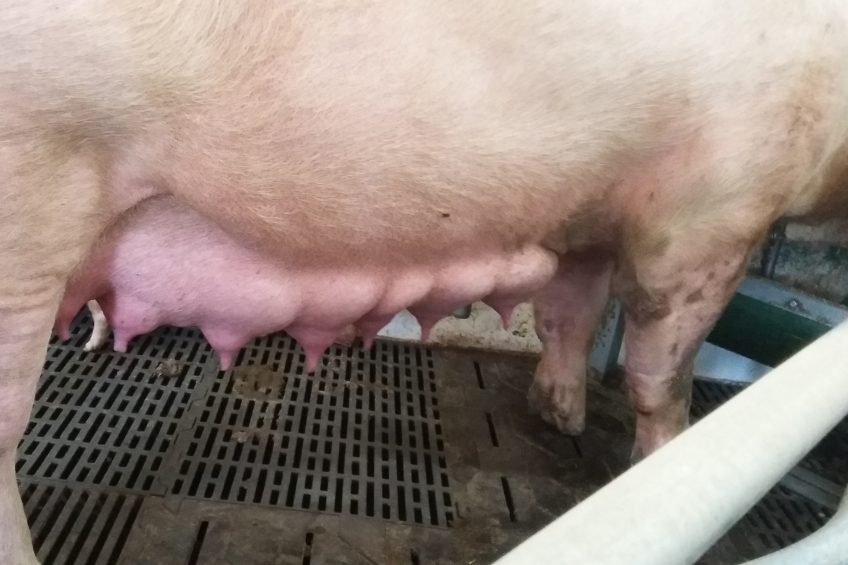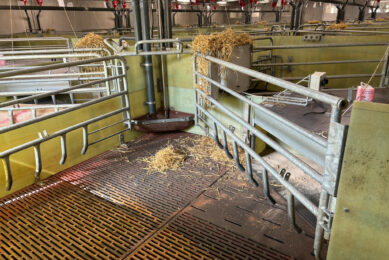Sows in the Champions League – how can we help?

Playing in Champions League for sows is possible – but not without hard work from staff – and sows, writes housing and welfare expert Vivi Aarestrup Moustsen.
Sows can produce 16 kg of milk per day, leading to 4 kg of daily piglet weight gain, and wean 16 piglets, if conditions are right. But no pain, no gain.
High prolific sows give birth to more piglets than they have teats. In addition, not all teats are always used. This leads to an increased use of nurse sows and/or use of supplementary milk.
Taking advantage of sow potential
But what is the potential of the sows and what does it take to take advantage of their potential?
As mentioned earlier in Pig Progress, the Danish Pig Research Centre visited 10 Danish commercial sow herds, where we counted, categorised and measured teats and glands of approximately 40 sows per herd, leading to information numbers and characteristics of teat and glands from 405 sows in total.
More than 50% of the sows had at least 14 teats, and 10% had 16 teats or more. However, number of teats doesn’t do it alone – indeed access to the teats for the piglets is of outmost importance.
Distances between sow teats
When sows are lying down, it’s important that the piglets can reach the upper row of teats. The measured distance between teat rows were equivalent to the height of 1-3 day old piglets. So, the piglets are able to reach the upper row.
The distances between teats in the same row must make room for the shoulder widths of piglets. The distance between teats in the same row decrease from the frontier teats towards teat number 4-6 and then increase again. Therefore, if weaning age exceeds 4 weeks, the access to the middle teats can become critical.
Great performances of high yielding sows
Research at Aarhus University by Uffe Krogh and Peter Theil and their colleagues have shown that close to 13,000 litres of blood runs through the udder of a high yielding sow every day carrying blood sugar equivalent to the sugar in approximately 300 cans of Coca Cola and close to 2 kg of fat.
The preferred sows are the ones having a high milk yield, high feed intake and moderate mobilisation.
Utilisation of feed
One way of increasing the utilisation the feed and thereby of the energy and fat in the blood is feeding regularly. A milk let-down occurs every hour, but 4-5 hour post-feeding, increasingly fewer nutrients from the feed will be absorbed by the blood. So if sows are only fed 2-3 times a day, the sow will be mobilising body resources for longer periods of time.
During late gestation, the sows’ energy requirement equals about 1.3 times their need for maintenance whereas the energy need during peak lactation will be nearly four times their need for energy for maintenance. High yielding sows are producing more milk already in early lactation, so these sows might benefit from a more rapid increase in feed compared to lower yielding sows leading to a lower loss of weight.
Are your sows playing in Champions League – or at the grounds behind the local pub? There are no easy answers. It will require an effort to answer – but it is also needed to know the current level to be able to decide how to improve the nursing capacity of the sows. As mentioned above milk production both depends on feed intake, feed ingredients, body mobilisation and the piglets’ access to the udder.
Potential for milk production
The potential for milk production and how to improve it on a farm level can be assessed by increasing the registration effort in a sub-group of sows for a period of 4-5 weeks:
• Count the number of teats;
• Adjust the farrowing crates to ensure there is easy access to the udder when the sows are nursing;
• Consider:
– Number of daily feedings;
– Feed level day 5;
– Feed level day 17;
– Total feed supplied for the individual sow during lactation;
– Numbers weaned per sow;
– Daily weight gain of the litter during lactation;
– Weight of the sows when entering the farrowing unit and at weaning.
Variation between sows
It’s important to both identify the average but not the least the variation between sows in the herd to point out potential for improvements. Are litter weights at weaning high – but sows losing weight? Are litter weights at weaning low and sows loosing limited weight? Is there a large variation between sow in weight loss during lactation?











